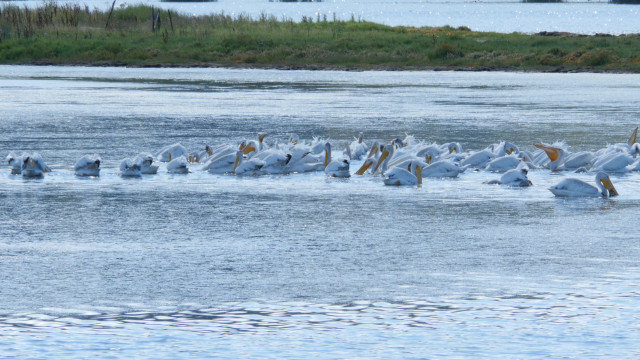
Sue Ehler easily spots a squadron of them through her binoculars from over a mile away, coming in for a landing on Puget Sound's Padilla Bay.
"They've got that pure white. It just shines like a bright light out there. More than the other white birds," Ehler says.
Ehler visits this estuary in Northwest Washington every other week from spring to fall with her friend and fellow citizen scientist and retired biologist Matt Kerschbaum. They're volunteers with the Skagit Heron Foraging Study, tracking the health of the largest breeding colony of great blue herons in the Pacific Northwest.
Ehler and Kerschbaum were among the first to notice the pelicans.
"It was like seeing aliens arrive," says Ehler, a seasonal biologist with a degree in ornithology. "It's unprecedented for them to be here, so something really unusual is happening."
White pelicans are different from brown pelicans, a more common summer visitor to coastal Washington. The white pelicans' range stretches across much of the country but not into Western Washington.
White Pelicans weren't a rarity in Washington a century ago, when they were common visitors to the state's inland waters. But their numbers fell due largely to habitat loss and pesticide use. In recent decades, populations have recovered to the point that the Washington Department of Fish and Wildlife is now recommending that they be uplisted from endangered to threatened.
At first Elher and Kerschbaum counted about a dozen white pelicans in Padilla Bay. But the ranks soon expanded.
"We had a baseline of nothing and suddenly we got a 130. So it kind of sets off the alarms that say, 'Maybe I should look into this a little bit,'" said Kerschbaum, a retired wildlife refuge manager with U.S. Fish and Wildlife.
They put out a call for sightings with area birding groups and Audubon societies and soon had more than 100 reports — not just in Puget Sound, but also on the Olympic Peninsula and north into coastal British Columbia.
"I wouldn't be surprised if they aren't prospecting for new locations," says Dan Roby, a professor of wildlife ecology at Oregon State University who studies pelicans and other birds. "White pelicans do seem to be expanding and establishing new sites. It seems like it's only a matter of time."
Roby says the pressures of climate change could be at play.
Climate Change Refugees
Normally the region's white pelicans spend the summer near breeding areas farther south and east, raising their young on islands in freshwater lakes and rivers. The surrounding water creates a natural barrier that protects the nestlings from predators. But with parts of Oregon and California are enduring another year of severe drought, prime breeding grounds like Malheur National Wildlife Refuge in Eastern Oregon have been hit hard.
(Story continues here)



Reader Comments
to our Newsletter